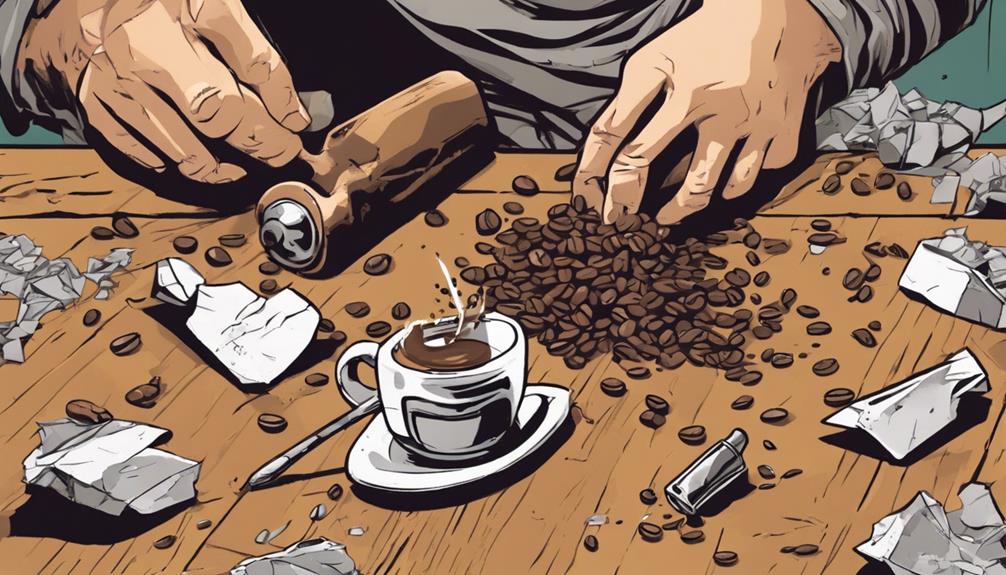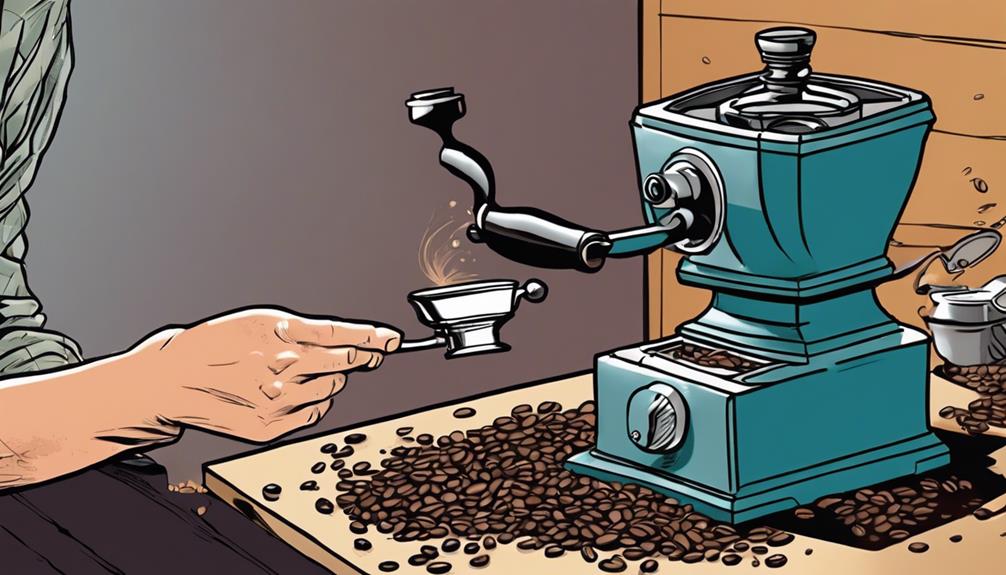To break coffee rock for home use, there are various methods you can try. You could heat it with firewood slowly for easier splitting, or use an electric jackhammer for softer rocks. If you have a tough one, consider the excavator jackhammer or the hand hammer method for a more hands-on approach. Another effective way is sand blasting, which is quick and efficient for breaking large rocks. Remember to wear safety gear and keep the area clear. Each method has its benefits, so choose wisely based on your needs. Get ready to crack those coffee rocks creatively! If you find yourself relying on your morning coffee to get through the day, consider implementing some strategies on how to reduce coffee consumption. Some options include gradually switching to decaf, cutting back on the number of cups you drink each day, or finding alternative drinks such as herbal teas or smoothies. By slowly decreasing your caffeine intake, you can minimize the potential withdrawal symptoms and still enjoy a satisfying beverage. Just remember, it’s all about finding a balance that works for you.
Key Takeaways
- Sand blasting offers swift and thorough coffee rock breakdown.
- Safety gear like goggles and gloves are essential for protection.
- Sand blasting is effective for tough rock surfaces.
- Clear the work area and have a first aid kit handy.
- Consider efficiency and safety when choosing a breaking method.
Heating With Firewood Method
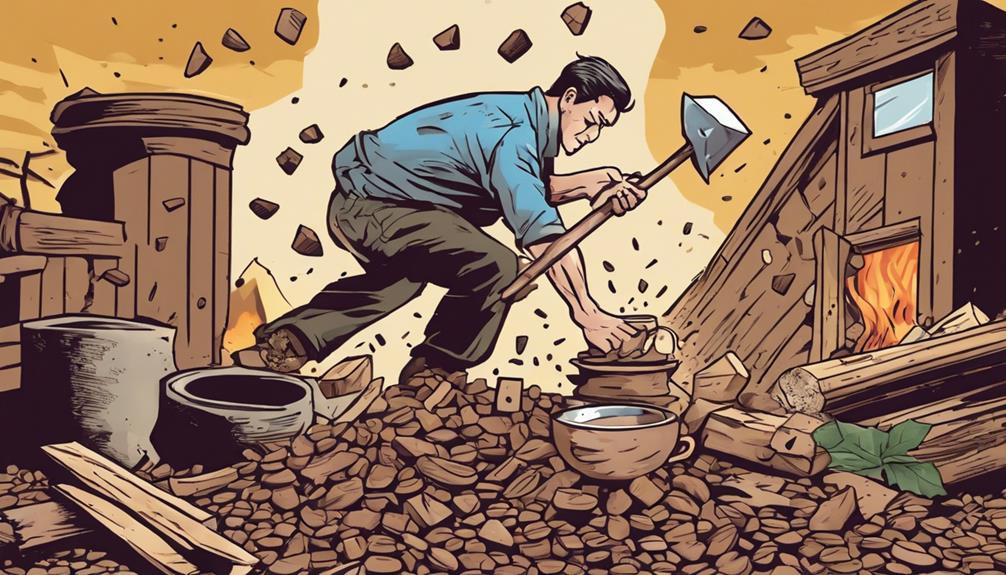
To break coffee rock using the firewood heating method, begin by warming the rock with firewood to facilitate easier splitting. Make sure to build a fire around the rock, allowing it to gradually absorb heat and expand. This process is slow and requires patience, as the rock needs to reach a high enough temperature to become more brittle for breaking.
Using a hammer and chisel, carefully strike the rock along its natural lines or fractures to aid in splitting it apart. Keep in mind that this method can be time-consuming, taking up to a week to fully break the rock depending on its size and composition.
The firewood heating method is best suited for smaller projects where time flexibility is available, as it's a traditional approach that involves manual labor and close monitoring of the rock's temperature. With diligence and perseverance, you can successfully break coffee rock using this technique.
Electric Jack Hammer Technique
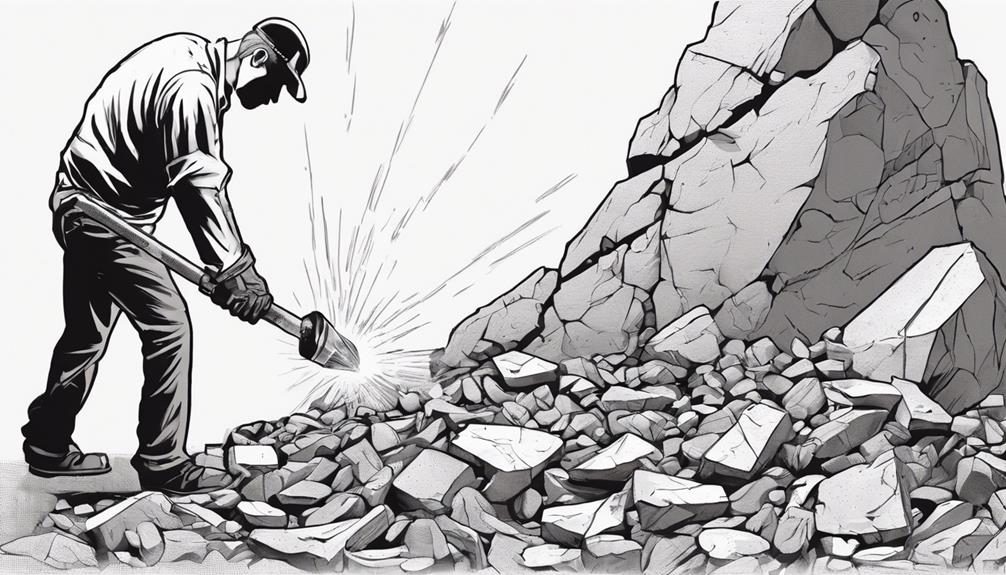
When breaking coffee rock for home use, consider utilizing the Electric Jack Hammer Technique for efficient and safe rock splitting. Electric jack hammers are appropriate for breaking softer coffee rocks to prevent harm to the machine.
However, it's important to note that this method isn't recommended for hard coffee rocks to avoid machine breakage. Caution is necessary when operating an electric jack hammer to guarantee safety and efficiency. These tools are more suitable for softer rock breaking tasks due to their design and capabilities.
When using an electric jack hammer, be aware of the rock's composition to determine the most efficient breaking technique.
- Electric jack hammers are appropriate for breaking softer coffee rocks to prevent machine harm.
- Caution is necessary when operating an electric jack hammer for safety and efficiency.
- Consider the rock's composition to determine the most efficient breaking technique.
Excavator Jackhammer Approach

When using the excavator jackhammer approach for breaking coffee rock at home, you'll find it to be an efficient method.
However, keep in mind that this technique consumes around 20 liters of diesel per hour, impacting its overall cost.
The sharpness of the chisel used with the excavator plays a significant role in its performance.
Efficient Rock Breaking
Consider using an excavator jackhammer method for effective rock splitting when dealing with tough coffee rocks at home. This technique is very efficient for rocks that need fast and strong splitting abilities.
The sharpness of the chisel used with the jackhammer greatly influences the performance, so make sure it's in top condition before beginning.
With this method, you can swiftly and effectively finish your rock splitting tasks at home.
- Effectively splits tough coffee rocks
- Perfect for fast and strong splitting
- Sharp chisel essential for top performance
Diesel Consumption Impact
To gauge the impact of diesel consumption when utilizing the Excavator Jackhammer method for breaking coffee rock, consider that this approach typically consumes around 20 liters of diesel per hour. The high diesel consumption is a direct result of the power and capacity required by the excavator to efficiently break hard rocks.
While this method is renowned for its quick job completion, it's important to factor in the cost of diesel into the project budget. The sharpness of the chisel used with the excavator jackhammer plays a significant role in its performance and efficiency when breaking the rock.
Understanding the diesel consumption impact is necessary for effective planning and execution of projects involving the Excavator Jackhammer method for breaking coffee rock. Make sure to evaluate the diesel usage carefully to manage costs and guarantee the successful completion of your rock-breaking endeavors.
Hand Hammer Breaking Process
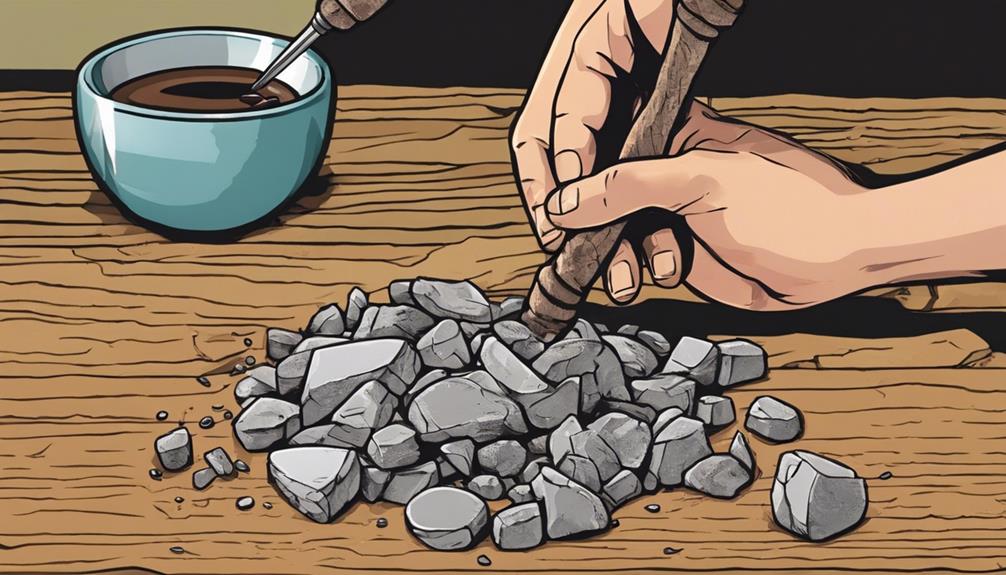
For small-scale projects, breaking coffee rock with a hand hammer is a manual and labor-intensive process. This method involves physically striking the rock with a hammer to break it into smaller, more manageable pieces. While it may be slower than using machinery, hand hammer breaking can be a cost-effective solution for small tasks where time flexibility isn't a concern.
Physical Effort: Breaking coffee rock with a hand hammer requires significant physical effort due to the force needed to fracture the rock effectively.
Time Consumption: The hand hammer method is time-consuming, as each strike only breaks off a small portion of the rock, making it a process that demands patience and endurance.
Cost-Effective: Despite its labor-intensive nature, hand hammer breaking can be a budget-friendly option for small projects where investing in machinery may not be justifiable.
Blasting With Sand Method
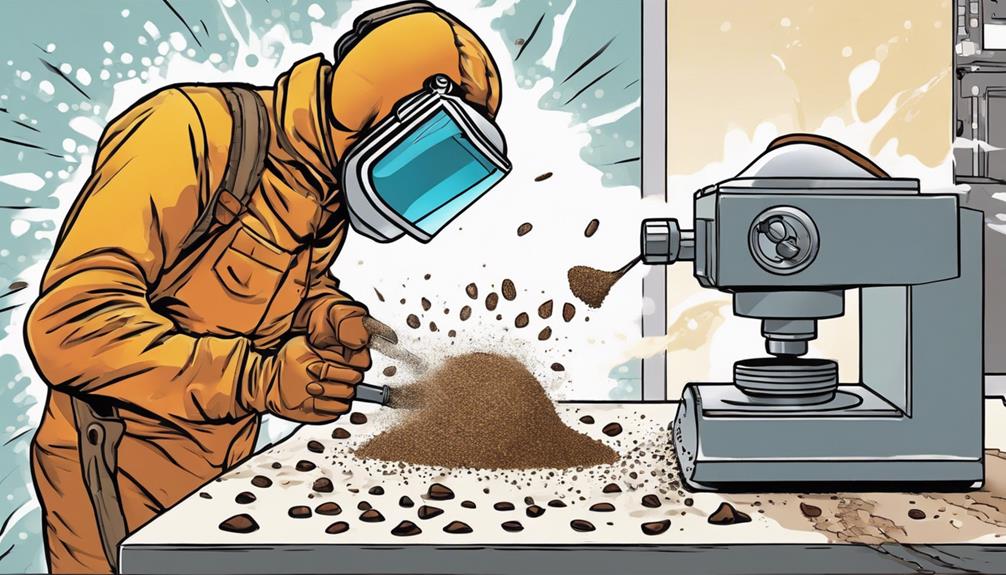
You'll learn the basics of sand blasting for breaking coffee rock at home.
Safety measures are essential when using this method to prevent accidents.
Discover the efficiency and effectiveness of sand blasting in breaking large coffee rock pieces.
Sand Blasting Basics
Using a hand controller to direct sharp sand-filled empty sec is vital in the sand blasting method for breaking coffee rock at home. Proper sand placement is necessary for safety and efficiency during the blasting process. This method allows for the force from sand blasting to effectively break coffee rock into smaller, usable pieces for home projects.
- Ensure Accuracy: Direct the sand-filled empty sec precisely towards the targeted area for efficient rock breaking.
- Maintain Safety Precautions: Wear appropriate protective gear, such as goggles and gloves, to prevent any injuries during the sand blasting process.
- Follow Blasting Protocols: Adhere to proper blasting techniques and guidelines to guarantee the effectiveness and success of breaking the coffee rock.
Sand blasting is an efficient and safe way to break large rocks at home without causing harm to individuals involved. By following these basic principles and guidelines, you can successfully utilize the sand blasting method for breaking coffee rock for your home projects.
Safety Measures Required
When engaging in the sand blasting method for breaking coffee rock at home, prioritizing safety measures is crucial. Making sure that proper precautions are in place can prevent accidents and injuries during the blasting process. Here are essential safety measures to contemplate before starting the blasting with sand method:
| Safety Measure | Description |
|---|---|
| Wear Protective Gear | Equip yourself with safety goggles, gloves, and a dust mask to shield against flying debris and dust inhalation. |
| Secure the Area | Clear the blasting area of any unnecessary objects or people to avert accidents and ensure a safe working environment. |
| Proper Sand Placement | Carefully fill the empty sec with sharp sand following recommended guidelines to achieve effective rock breaking without risks. |
| Follow Manufacturer's Instructions | Adhere to the instructions provided with the blasting equipment to guarantee safe and efficient operation. |
| Use Hand Controller Cautiously | Handle the hand controller with care and only trigger the explosion when all safety measures are in place to evade accidents. |
Efficiency and Effectiveness
Breaking coffee rock using the sand blasting method proves to be a highly efficient and effective approach for tackling large rocks. This technique involves utilizing a hand controller to trigger the blasting with sharp sand-filled empty sec.
By following proper safety precautions diligently, you can guarantee the protection of both workers and equipment during the blasting process. The method stands out for its effectiveness in breaking down large rocks swiftly and thoroughly, providing prompt results for your rock-breaking tasks.
Remember, the proper placement of sand is crucial to the success of the blasting process.
- Prompt Results: Sand blasting allows for quick and efficient breaking of large coffee rocks.
- Thorough Breakdown: This method ensures a comprehensive breakdown of the rocks, leaving you with smaller, more manageable pieces.
- Effective Technique: The sand blasting method has proven to be highly effective in handling even the toughest coffee rock formations.
Safety Precautions and Considerations
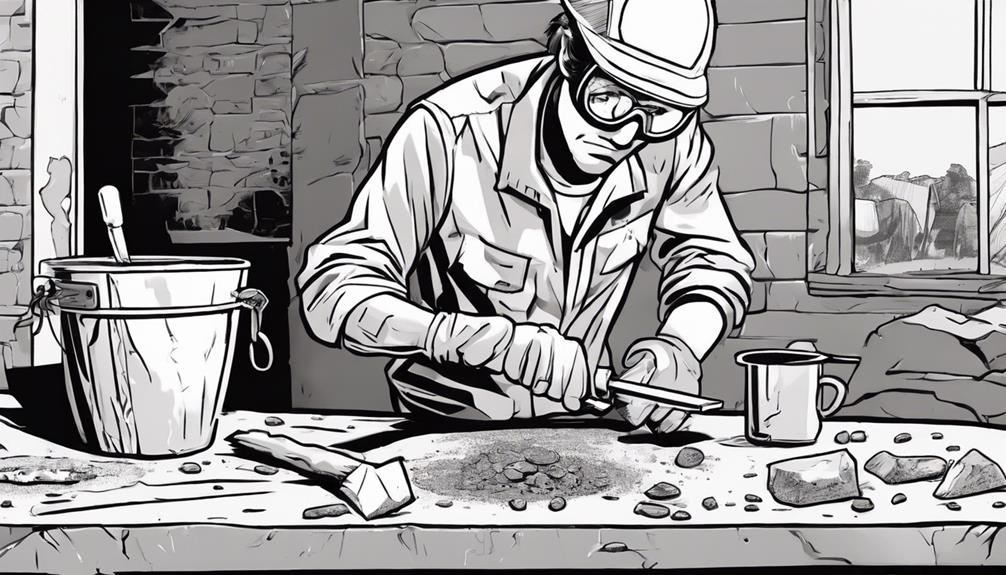
For safe handling of coffee rock at home, always prioritize wearing appropriate safety gear and clearing the work area of any potential hazards. Before breaking coffee rock, ensure you have goggles to protect your eyes, gloves to safeguard your hands, and sturdy footwear for foot protection. It's crucial to have a clear workspace, free of any debris or objects that could cause tripping or falling hazards during the breaking process. Remember to follow the proper techniques and guidelines for using your chosen breaking method to prevent injuries. Additionally, keep a first aid kit nearby to address any minor injuries or accidents that may occur. If you are unsure about the safety aspects of breaking coffee rock on your own, it's advisable to seek professional assistance or guidance to ensure a safe process.
| Safety Gear Required | Work Area Preparation | First Aid Kit Availability |
|---|---|---|
| Goggles | Clear of Debris | Accessible and Stocked |
| Gloves | Free of Bystanders | Equipped for Minor Injuries |
| Sturdy Footwear | Hazard-Free Environment | Ready for Immediate Use |
Efficiency Comparison of Methods
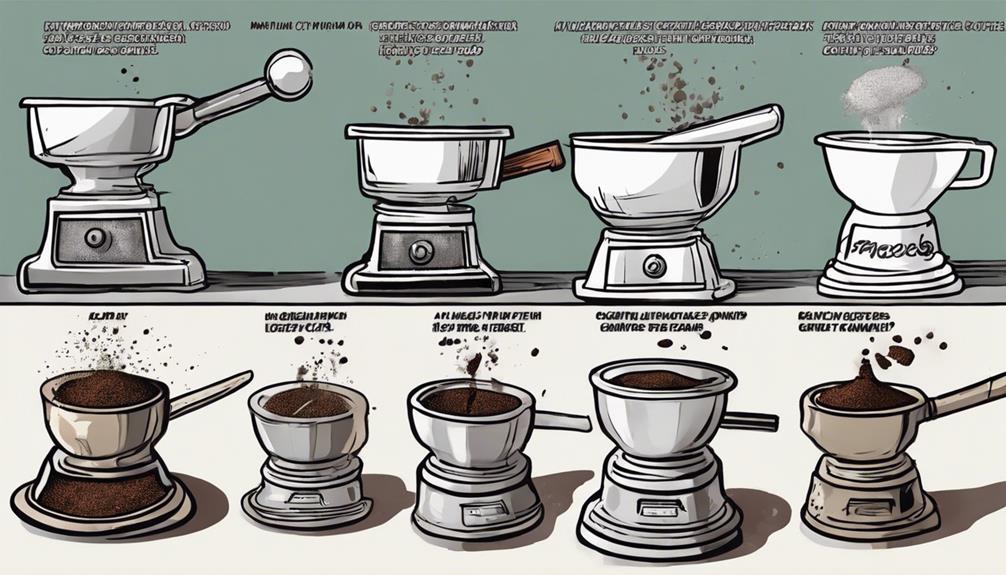
Guarantee efficiency in breaking coffee rock at home by comparing different methods for their effectiveness and speed. When deciding on the best approach, consider the following:
- Electric Jack Hammer: Suitable for softer rocks, but be cautious as it may risk machine breakage.
- Excavator Jackhammer: Consumes around 20 liters of diesel per hour and is efficient for breaking hard rocks quickly.
- Firewood Heating Method: Slow and time-consuming, involving manual labor with a hammer and chisel.
Each method has its pros and cons. The Electric Jack Hammer is ideal for softer rocks but requires careful handling.
The Excavator Jackhammer is great for hard rocks, providing quick results but at a higher fuel consumption rate.
On the other hand, the Firewood Heating Method is more labor-intensive and time-consuming. Consider these factors along with your project requirements to choose the most suitable method for breaking coffee rock efficiently at home.
Choosing the Right Method for You
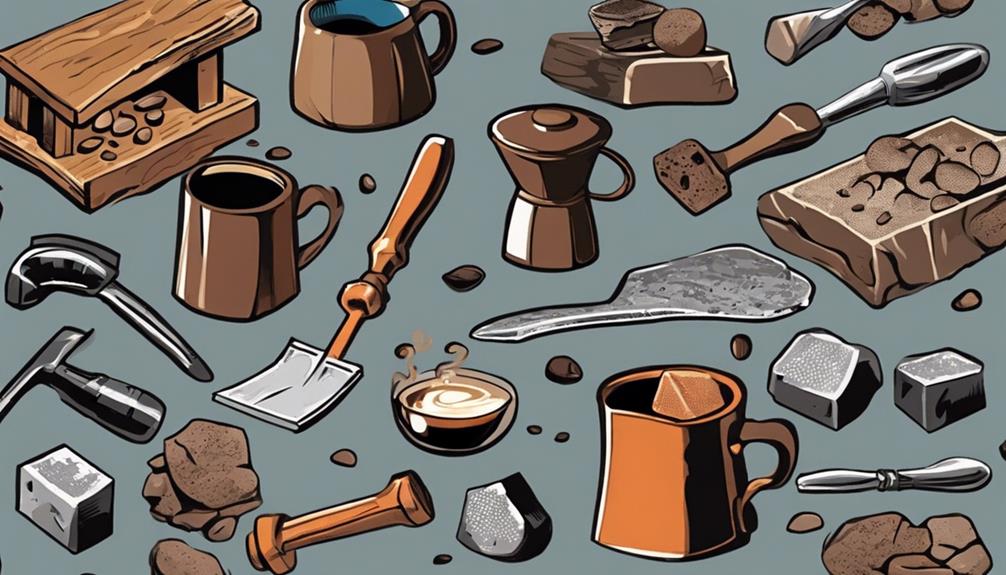
Consider your project requirements and the hardness of the rock to determine the most suitable method for breaking coffee rock efficiently at home.
If you're dealing with softer rocks, an electric jackhammer might be the way to go due to its ability to break through them effectively.
On the other hand, for harder coffee rocks, using an excavator jackhammer could provide the necessary power to crack them open.
If you prefer a slower but still effective method, utilizing firewood heating can gradually break down the rock.
For smaller projects where manual labor is feasible, hand hammers can be a practical option.
However, if you have a large rock-breaking task at hand, blasting could be the most efficient method, although it requires careful adherence to safety measures.
Frequently Asked Questions
How Do You Break Rocks at Home?
To break rocks at home, you can use methods like electric jackhammers for softer rocks or hand hammers for smaller projects. Excavator jackhammers are efficient but consume fuel. Safety is essential when blasting large rocks with sand-filled sec.
What Is the Best Tool to Break Rocks?
For breaking rocks at home, the best tool depends on the rock's hardness. Electric jack hammers work well for softer rocks, while excavator jackhammers are efficient for hard rocks. Consider the task's size and safety precautions.
How to Break Rock Without Blasting?
Avoid the mess and noise of blasting by breaking rocks at home using methods like an electric jackhammer or firewood heating. Prioritize safety and choose the most suitable method based on the rock's hardness.
How to Break up a Rock in the Ground?
To break up a rock in the ground, start by evaluating its hardness. Use an electric jackhammer for softer rocks to prevent machine damage. For hard rocks, opt for an excavator jackhammer for efficient and quick results.
Conclusion
Now that you know the different methods for breaking coffee rock at home, you can choose the one that suits you best. Whether you prefer the traditional hand hammer approach or the more modern electric jack hammer technique, there's a method for everyone.
Just remember to prioritize safety and efficiency in your decision-making process. So go ahead, break that coffee rock and enjoy using it in your home decor or landscaping projects!
